| Listing 1 - 10 of 18 | << page >> |
Sort by
|
Book
ISBN: 0444818472 9786611716486 1281716480 0080879934 9780444818478 Year: 1994 Volume: 84 Publisher: Amsterdam New York Elsevier
Abstract | Keywords | Export | Availability | Bookmark
 Loading...
Loading...Choose an application
- Reference Manager
- EndNote
- RefWorks (Direct export to RefWorks)
These proceedings, comprising 7 plenary lectures, 100 oral and 175 poster presentations, reflect present activities in the field of microporous materials. The International Zeolite Conferences are devoted to all aspects of zeolite science and technology. The term zeolite is to be understood in its broadest sense comprising all kinds of crystalline microporous materials regardless of their composition (e.g. aluminosilicates and other metallosilicates, silica, aluminophosphates, gallophosphates etc.), occurring in nature or synthesized by man. Mesoporous silica, aluminosilicates and other
Zeolites --- Molecular sieves --- Congresses --- Chemical engineering --- Drying agents --- Sieves --- Sorbents --- Zeolites - Congresses --- Molecular sieves - Congresses
Book
ISBN: 953515382X 9535111515 Year: 2013 Publisher: IntechOpen
Abstract | Keywords | Export | Availability | Bookmark
 Loading...
Loading...Choose an application
- Reference Manager
- EndNote
- RefWorks (Direct export to RefWorks)
Molecular Toxinology has been consolidated as a scientific area focused on the intertwined description of several aspects of animal toxins. In an inquiring biotechnological world, animal toxins appear as an invaluable source for the discovery of therapeutic polypeptides. Animal toxins rely on specific chemical interactions with their partner molecule to exert their biological actions. The comprehension of how molecules interact and recognize their target is essential for the rational exploration of bioactive polypeptides as therapeutics. Investigation on the mechanism of molecular interaction and recognition offers a window of opportunity for the pharmaceutical industry and clinical medicine. Thus, this book brings examples of two interconnected themes - molecular recognition and toxinology concerning to the integration between analytical procedures and biomedical applications.
Molecular sieves. --- Chemical engineering --- Drying agents --- Sieves --- Sorbents --- Medical toxicology
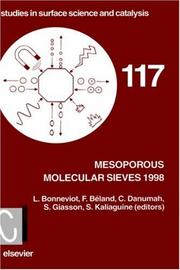
ISBN: 9780444828262 0444828265 9780080536248 0080536247 9786611058517 1281058513 Year: 1998 Publisher: Amsterdam New York Elsevier
Abstract | Keywords | Export | Availability | Bookmark
 Loading...
Loading...Choose an application
- Reference Manager
- EndNote
- RefWorks (Direct export to RefWorks)
The original properties of mesoporous molecular sieves are so unique that the design of most existing catalysts could be reconsidered. It might indeed be of interest to introduce MMS either as a support or as the active phase, merely on the basis of their high surface areas, narrow pore size distribution and flexibility in composition. The recent literature provides examples of MMS based catalysts of many types such as acid-base solids, supported metals and supported oxides, mixed oxides, anchored complexes and clusters, grafted organic functional groups and others. Examples of all these devel
Molecular sieves --- Chemical engineering --- Drying agents --- Sieves --- Sorbents
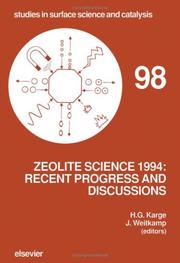
ISBN: 0444823085 9786611057442 1281057444 0080544703 9780444823083 9780080544700 Year: 1995 Volume: 98 Publisher: Amsterdam New York Elsevier
Abstract | Keywords | Export | Availability | Bookmark
 Loading...
Loading...Choose an application
- Reference Manager
- EndNote
- RefWorks (Direct export to RefWorks)
This book is a supplementary volume to J. Weitkamp et al. (Editors), Zeolites and Related Microporous Materials: State of the Art 1994 - Proceedings of the 10th International Zeolite Conference, Garmisch-Partenkirchen, Germany, July 17-22, 1994. The larger part of this supplementary volume contains full texts of the Recent Research Reports, which were presented as posters, and the discussions of all the lectures and posters. One full paper is included, because one page was missing in the version published in the Proceedings. A complete list of participants is also included.
Zeolites --- Molecular sieves --- Congresses --- 549.67 --- -Molecular sieves --- -Chemical engineering --- Drying agents --- Sieves --- Sorbents --- Silicate minerals --- -Zeolites --- 549.67 Zeolites --- -549.67 Zeolites --- Chemical engineering --- Zeolites - Congresses --- Molecular sieves - Congresses
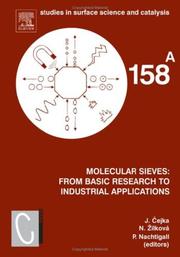
ISBN: 0444520821 0444516700 044452083X 9786610968459 1280968451 0080473512 0080960871 9780444520821 9780080473512 9780444516701 9780444520838 Year: 2005 Publisher: Amsterdam ; Boston : Elsevier,
Abstract | Keywords | Export | Availability | Bookmark
 Loading...
Loading...Choose an application
- Reference Manager
- EndNote
- RefWorks (Direct export to RefWorks)
Due to their unique porous properties, zeolites (also referred to as molecular sieves) are used in a variety of applications - major uses are in petrochemical cracking, ion-exchange (water softening and purification), and in the separation and removal of gases and solvents. Molecular Sieves: From Basic Research to Industrial Applications, Volume 158 A,B presents over 265 worldwide contributions on the latest developments in zeolitic research. Readers will find this book, which is divided into five sections: Synthesis, Characterization, Adsorption, Catalysis, and Novel applications, id
Zeolites --- -Silicate minerals --- Congresses --- Conferences - Meetings --- Molecular sieves -- Industrial applications -- Congresses. --- Molecular sieves -- Research -- Congresses. --- Zeolites -- Industrial applications -- Congresses. --- Molecular sieves --- Chemical engineering --- Drying agents --- Sieves --- Sorbents --- Silicate minerals --- Industrial applications --- Research --- -Congresses
Periodical
ISSN: 18733093 13871811 Year: 1998 Publisher: New York : Elsevier Science,
Abstract | Keywords | Export | Availability | Bookmark
 Loading...
Loading...Choose an application
- Reference Manager
- EndNote
- RefWorks (Direct export to RefWorks)
Molecular sieves --- Zeolites --- Porous materials --- Porosity --- Tamis moléculaires --- Zéolites --- Porosity. --- Zeolites. --- Molecular sieves. --- Porosities --- Zeolite --- Silicate minerals --- Chemical engineering --- Drying agents --- Sieves --- Sorbents
Periodical
ISSN: 18733115 Year: 1981 Publisher: Guildford, England : IPC Science and Technology Press
Abstract | Keywords | Export | Availability | Bookmark
 Loading...
Loading...Choose an application
- Reference Manager
- EndNote
- RefWorks (Direct export to RefWorks)
Zeolites --- Molecular sieves --- Chemical engineering --- Drying agents --- Sieves --- Sorbents --- Silicate minerals
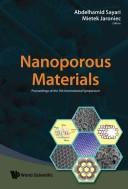
ISBN: 1281937967 9786611937966 9812779167 9789812779168 9812779159 9789812779151 Year: 2008 Publisher: Hackensack, NJ World Scientific
Abstract | Keywords | Export | Availability | Bookmark
 Loading...
Loading...Choose an application
- Reference Manager
- EndNote
- RefWorks (Direct export to RefWorks)
This proceedings volume contains selected and peer-reviewed original oral and poster contributions to be presented at the 5th International Symposium on Nanoporous Materials, Vancouver, Canada, May 25-28, 2008. It presents recent scientific advances in the area of nanoporous materials, especially those with ordered pores of sizes between 1 and 50 nm, their synthesis, characterization and applications in adsorption, catalysis, bio-related processes, environmental cleanup and nanotechnology. A unique feature of this volume is the wide variety of nanoporous materials covered, ranging from ordered silica nanostructures, silicas with incorporated organic and inorganic species, ordered nanoporous carbons and polymers, metal organic frameworks, nanostructured catalysts to nanoporous films, membranes and monoliths. This proceedings volume reflects the current trends and advances in the field of nanomaterials, which will certainly continue to attract the attention of materials scientists around the globe. It will therefore be a valuable reference for materials scientists, chemists and physicists working in academia, national and industrial laboratories.
Porous materials --- Nanostructured materials --- Silica --- Molecular sieves --- Silicon dioxide --- Oxides --- Silicon compounds --- Chemical engineering --- Drying agents --- Sieves --- Sorbents
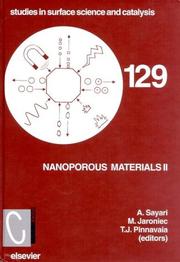
ISBN: 9780444503213 0444503218 9780080537269 008053726X 9786611057220 1281057223 Year: 2000 Publisher: New York : Elsevier,
Abstract | Keywords | Export | Availability | Bookmark
 Loading...
Loading...Choose an application
- Reference Manager
- EndNote
- RefWorks (Direct export to RefWorks)
The first symposium on Access in Nanoporous Materials was held in Lansing, Michigan on June 7-9, 1995. The five years that have passed since that initial meeting have brought remarkable advances in all aspects of this growing family of materials. In particular, impressive progress has been achieved in the area of novel self-assembled mesoporous materials, their synthesis, characterization and applications. The supramolecular self-assembly of various inorganic and organic species into ordered mesostructures became a powerful method for synthesis of mesoporous molecular sieves of tailored framew
Mechanical properties of solids --- Materials sciences --- Porous materials --- Nanostructured materials --- Zeolites --- Silica --- Molecular sieves --- Chemical engineering --- Drying agents --- Sieves --- Sorbents --- Silicon dioxide --- Oxides --- Silicon compounds
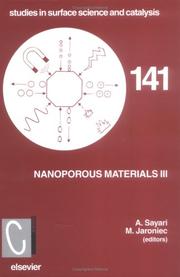
ISBN: 9780444511133 044451113X 0080537227 9780080537221 9786611112134 1281112135 Year: 2002 Publisher: Amsterdam ; Boston : Elsevier,
Abstract | Keywords | Export | Availability | Bookmark
 Loading...
Loading...Choose an application
- Reference Manager
- EndNote
- RefWorks (Direct export to RefWorks)
Nanoporous Materials III contains the invited lectures and peer-reviewed oral and poster contributions to be presented at the 3rd Conference on Nanoporous Materials, which will be hosted in Ottawa, Canada, June 2002. The work covers complementary approaches to and recent advances in the field of nanostructured materials with pore sizes larger than 1nm, such as periodic mesoporous molecular sieves M41S and FSM16 and related materials including clays, carbon molecular sieves, colloidal crystal templated organic and inorganic materials, porous polymers and sol gels. The broad range of topi
Mechanical properties of solids --- Materials sciences --- Porous materials --- Nanostructured materials --- Silica --- Molecular sieves --- Chemical engineering --- Drying agents --- Sieves --- Sorbents --- Silicon dioxide --- Oxides --- Silicon compounds
| Listing 1 - 10 of 18 | << page >> |
Sort by
|

 Search
Search Feedback
Feedback About UniCat
About UniCat  Help
Help News
News